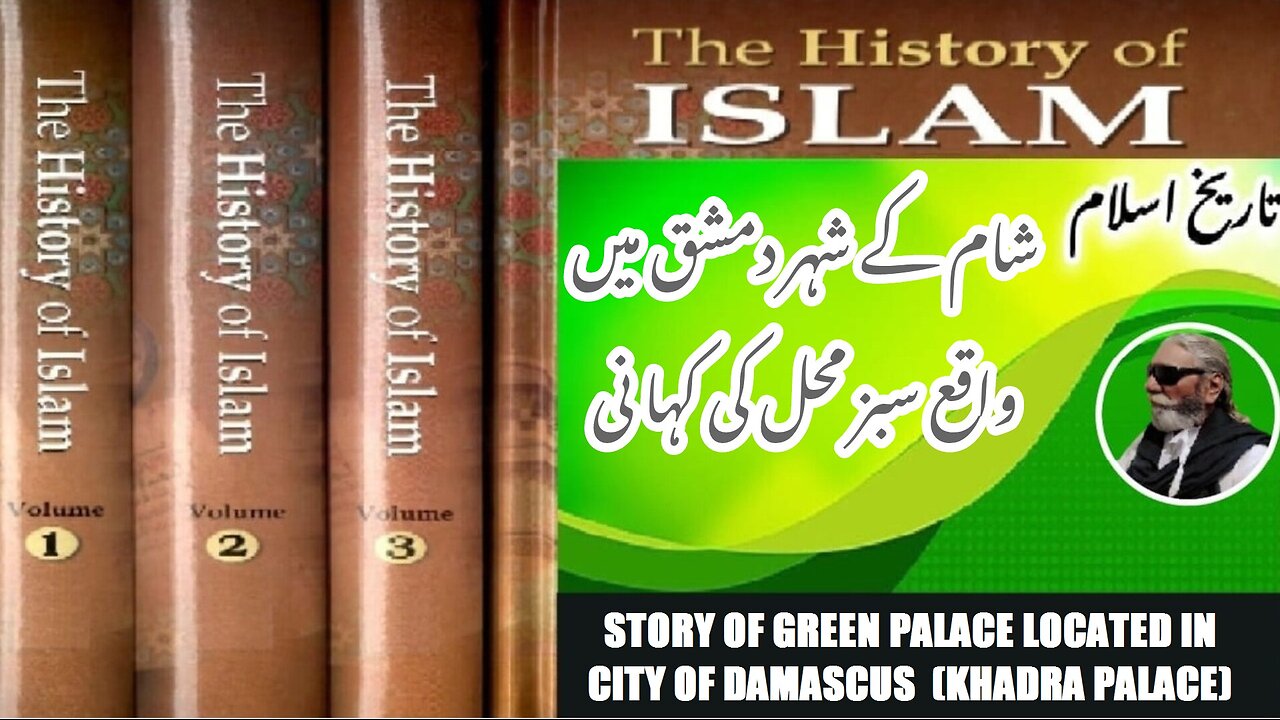Premium Only Content

What is story of green palace in city damascus of syria which also called khadra palace
Asslamoalaikum, sisters brothers friends and elders, we are discribing that What is story of green palace in city damascus of syria? which also called khadra palace
The Green Dome , was a residence of the Umayyad caliphs in Damascus. It was founded by the first Umayyad caliph, Mu'awiya I (r.?661–680), while he was governor of Syria under Caliph Uthman (r.?644–656). The Khadra Palace consisted of a series of interconnected buildings, including the caliphal residence, stables, mint and prison, situated directly behind the Umayyad Mosque. Little information is available describing the structure, other than the green color of its dome, its construction from baked brick, timber and marble pavement and its setting amid gardens.
It remained in official use after the fall of the Umayyads and transfer of the caliphate to Iraq by the Abbasids in 750. It was probably destroyed during the Fatimid period in the 10th or 11th century and there are no known traces of the structure.
Location and composition
The Khadra Palace was situated immediately south of the Umayyad Mosque, which until Caliph al-Walid I's reconstruction, had consisted of only a part of the Christian cathedral of John the Baptist.[1] The palace originally lay behind the mosque's Mihrab of the Companions, which in Mu'awiya's time served as the mosque's central mihrab (prayer niche) in the southeastern section of the qibla (prayer direction) wall.[2]
History
There is little information available in the literary sources about the Khadra Palace. The original structure may have been a Byzantine palace for the governor of Damascus or was founded by Mu'awiya, the governor of Syria under Caliph Uthman. His brother and predecessor, Yazid ibn Abi Sufyan, also built a palace in the city.[3] Mu'awiya became caliph in 661, establishing the capital of the newly-founded Umayyad Caliphate in Damascus.
The Khadra Palace was built of baked brick and timber and paved with marble. It was amid gardens characterized by fountains, myrtles and vines. An anecdote about Mu'awiya rebuilding it of stone in response to a Byzantine envoy's comment that the palace was fit for birds and rats, is probably a topos, according to the historian Finbar Barry Flood.[4] The Khadra Palace probably included the other structures directly behind mosque, including the mint, barracks, stables and prison, all separate buildings connected to each other in a complex with a courtyard in its center.[5]
The Umayyad caliph Abd al-Malik (r.?685–705) purchased the palace from Mu'awiya's grandson Khalid ibn Yazid and used it as his residence in the city.[3] Abd al-Malik's son and successor al-Walid I possibly remodeled the palace when he ordered the construction of the Umayyad Mosque.[6]
Reports that the palace was destroyed by the Abbasids are likely false. The Abbasids may have used the Khadra Palace or the Palace of Yazid ibn Abi Sufyan as a prison. Successive Umayyad pretenders to the caliphate who took control of Damascus during the Great Abbasid Civil War, Abu al-Umaytir al-Sufyani and Maslama ibn Ya'qub al-Marwani, used the Khadra Palace as their seat of power in 811–813 until being driven out by Abbasid loyalists.[8] Reports by Muslim geographers attest to its existence and location through the 10th century. It was destroyed during Fatimid rule of the city in the 11th century. The 12th-century traveler Ibn Jubayr remarked that the city's Coppersmiths Row, "there is no more beautiful-looking row of shops than this", behind the Umayyad Mosque was formerly the site of the Khadra Palace.[6] There are no known traces of the structure.
We pray to Allah almighty to give us permission to read and understand truth of our history islam. Ameen Allah Hafiz
=============================================
-
 6:54
6:54
ISLAMIC HISTORY
49 minutes agoBiography of Indoneshian Dr Siti Mosaddeq Mallya انڈونیشیا کی ڈاکٹر سیتی مصدق مالیا کی سوانح عمری
1 -
 LIVE
LIVE
MattMorseTV
1 hour ago $3.02 earned🔴Trump's meeting with Zelenskyy - LIVE🔴
1,521 watching -
 DVR
DVR
Nikko Ortiz
2 hours agoLive - News, Politics, Podcast And Naaah Im Playin We Chillen
23.5K3 -
 LIVE
LIVE
Steven Crowder
3 hours ago🔴Can Donald Trump Bring Peace: Zelensky and EU Leaders Massive visit to Washington
24,102 watching -
 LIVE
LIVE
Nerdrotic
2 hours agoSuperman GUNNED DOWN | Marvel Phase SUX - Nerdrotic Birthday Nooner 508
287 watching -
 LIVE
LIVE
Side Scrollers Podcast
1 hour agoPETA AMBUSHES Nintendo + UK THREATENS 4Chan + Roblox Situation Is Crazy | Side Scrollers Live
238 watching -
 LIVE
LIVE
Viss
1 hour ago🔴LIVE - Learn To Dominate Battle Royale with Tactics and Strategy! - PUBG
100 watching -
 LIVE
LIVE
LFA TV
6 hours agoLFA TV ALL DAY STREAM - MONDAY 8/18/25
4,589 watching -
 LIVE
LIVE
The Mel K Show
1 hour agoMORNINGS WITH MEL K -Buckle Up! The Old Guard Will Not Go Quietly 8-18-25
876 watching -
 LIVE
LIVE
Flyover Conservatives
11 hours agoEpstein Files, FBI Failures & The Fight for Real Accountability - Breanna Morello | FOC Show
226 watching